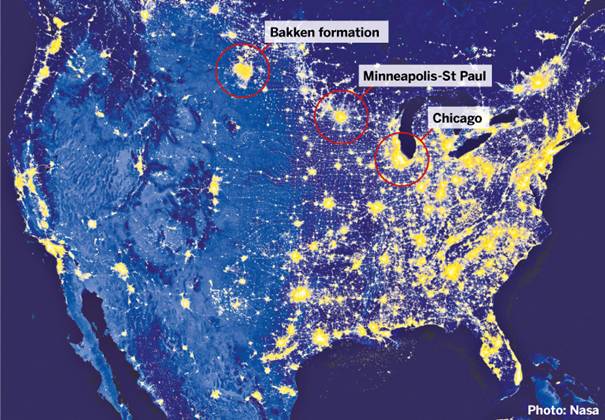Due to the unconventional oil and (shale) gas boom in the US, gas flaring in North Dakota and Texas is visible from outer space. In fact, the amount of gas flared would be enough to simultaneously power the cities of Chicago and Washington… Although environmentalists’ concerns are growing increasingly vocal, the rise of shale gas production has actually contributed to a decrease in US CO2 emissions overall.
As the Financial Times reports, night-time satellite images clearly show that vast amounts of gas are being flared in the shale-producing areas of the US. (What is flaring? – see box below.) Consider, for example, the state of North Dakota, the flagship of the US shale boom, where the volume of flared gas has increased by 50% over the past year. This highlights the rapid and dramatic growth of the American gas industry – especially given that the majority of the gas is actually put to use.

Dakota, we have a problem. Source: Financial Times; NASA
Gas is the least CO2-intensive fossil fuel. Nonetheless, burning it without putting the released energy to use increases environmental stress. Over the past few years, the US has emerged as one of the world’s greatest polluters in terms of flaring: according to the World Bank, only Russia, Nigeria, Iran and Iraq precede it in the global ranking; not very “green” countries, to say the least. Overall – although environmentalists often seem to forget about this – US CO2 emissions have substantially decreased even with flaring, simply because they burn more natural gas than coal. (See our previous posts on this issue here and here.)
Flaring is the burning of surplus and unused gas produced as part of oil and gas production. Flaring results from economic (and not technical) considerations, primarily because of the low (North American) gas price.
In general, everyone wants to find oil or some other similar liquid, meaning that gas has become so cheap it is practically considered a side-product. At such low prices, the construction of pipelines and tankers needed for the transport of surplus gas is not economical. Due to the lack of infrastructure, many companies see no other option than simply flaring the gas.
What could be the solution? In the short term, building the necessary infrastructure would not be economical at current prices. If the US is indeed worried about flaring, the introduction of some form of new tax could be a possible option, since this would create an incentive for actually putting the gas to use. A general carbon tax could do a lot for reducing flaring. In fact, North Dakota’s legislature is already considering a proposal that would give tax breaks to companies cutting back on flaring.
Over the long term, however, the situation may be very different. If US gas exports were to come on stream, it would allow other countries and consumers to benefit from cheap gas, and also make it economical to construct pipelines and start exports instead of flaring. Of course, this wouldn’t happen from one day to the other, and small, isolated fields would probably not be connected to any such pipeline. Therefore, where it is economical, the infrastructure will likely be built – and while it’s worth taking it for free, we suggest the techniques used by gas thieves in China:

Gas theft by balloon. Source: National Geographic
A bejegyzés trackback címe:
Kommentek:
A hozzászólások a vonatkozó jogszabályok értelmében felhasználói tartalomnak minősülnek, értük a szolgáltatás technikai üzemeltetője semmilyen felelősséget nem vállal, azokat nem ellenőrzi. Kifogás esetén forduljon a blog szerkesztőjéhez. Részletek a Felhasználási feltételekben és az adatvédelmi tájékoztatóban.




